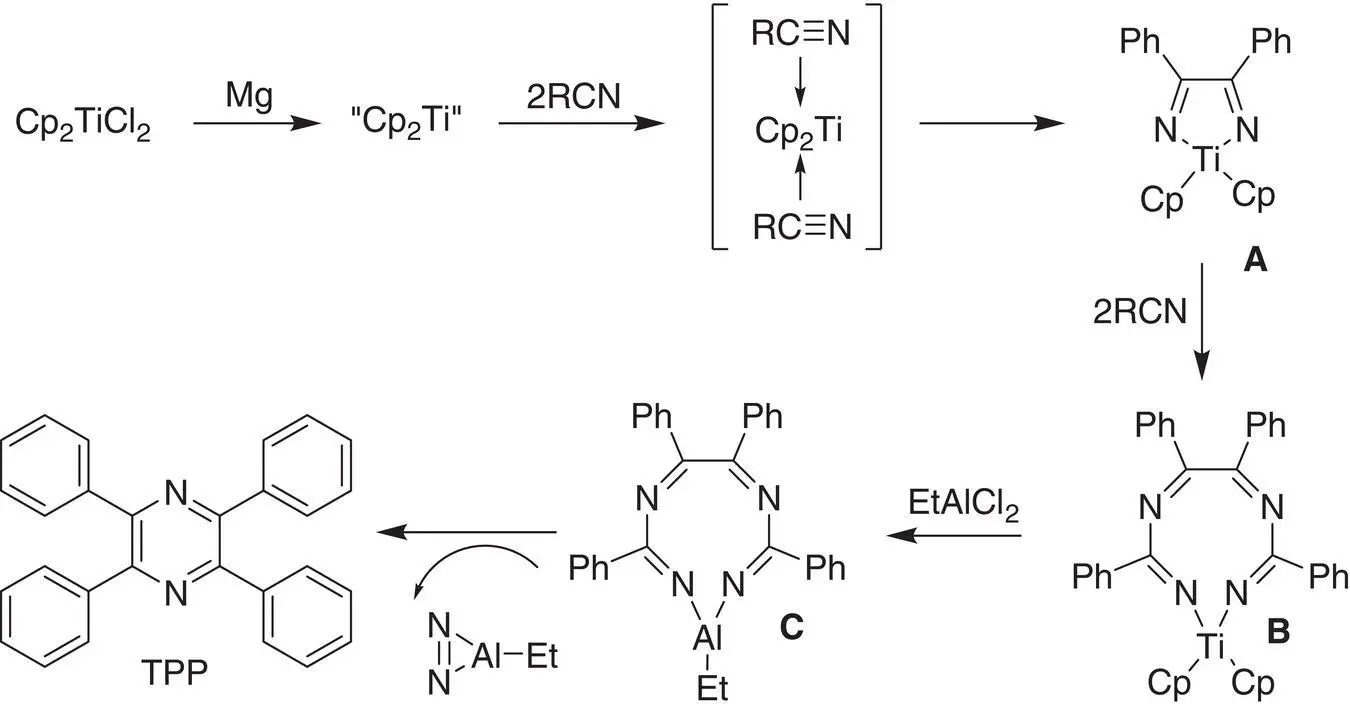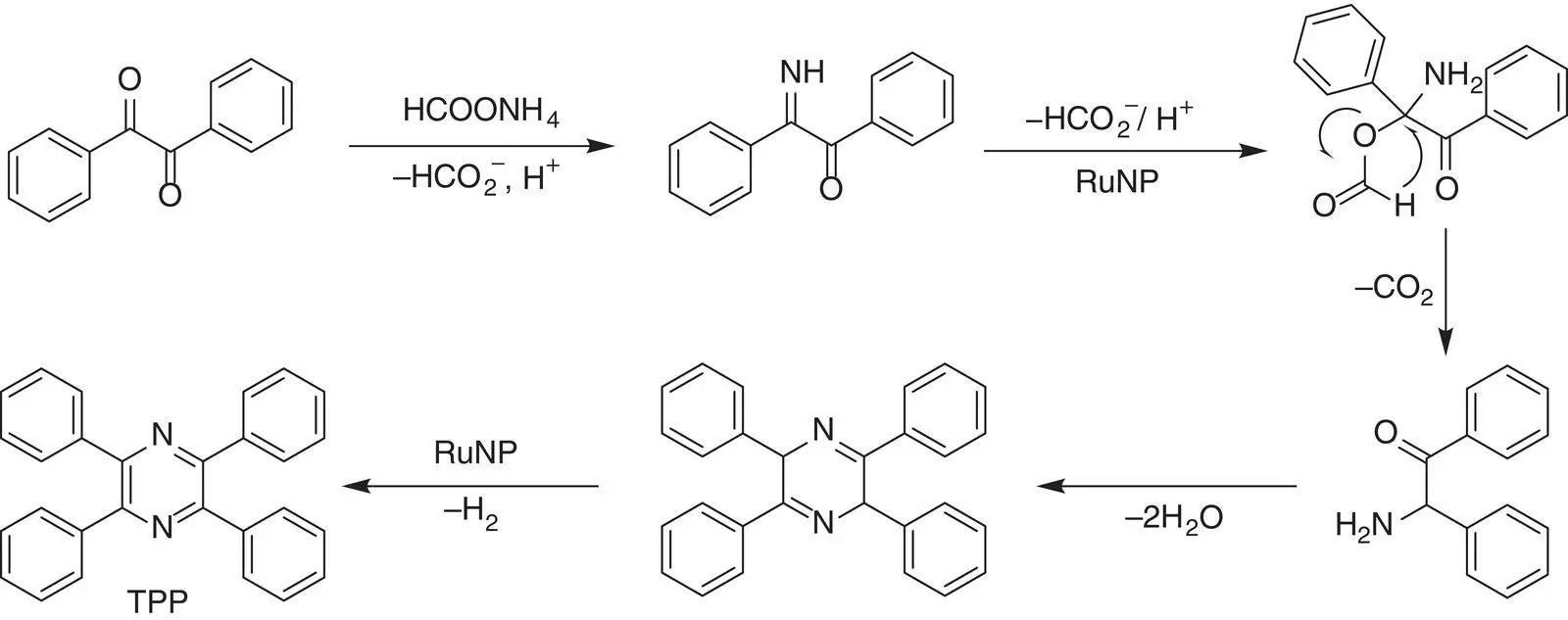1 ...8 9 10 12 13 14 ...42 Khafizova reported a new one‐pot synthesis of tetrasubstituted TPP derivatives based on the reaction of nitriles with EtAlCl 2catalyzed by metallic Mg and Cp 2TiCl 2( Scheme 1.2, Route B) [47]. The reaction is efficient, and the product can be obtained in good yields of 60–90%. The catalytic system of Ti and Zr complexes such as Cp 2TiCl 2, Ti(Pr iO) 4, TiCl 4, Cp 2Ti(PMe 3) 2, Ti(acac) 2Cl 2, Ti(Net 2) 4, and Cp 2ZrCl 2is investigated to examine the influence on the reaction. Only Cp 2TiCl 2and Ti(Pr iO) 4display superior catalytic activity and selectivity. Besides, the reaction has a wide universality of nitriles. For example, by using the starting materials of 2‐methyl‐, 3‐methyl‐, 4‐methyl‐, 4‐isopropyl‐, 3,5‐dimethyl‐, and 4‐methoxy‐substituted benzonitriles, different TPP derivatives with the tetrasubstituents can be obtained efficiently. The probable mechanism of this reaction was also given. Cp 2TiCl 2was first reduced to the coordinatively unsaturated Cp 2Ti(II) complex by activated Mg. Then, two nitriles can coordinate with the Cp 2Ti(II) complex to form titanium‐nitrile π ‐complexes, followed by transforming to diazatitanacyclopentadiene intermediate A. Subsequently, two additional nitrile molecules are inserted into the active Ti–N bonds of the intermediate, which gives rise to ring expansion to form the unsaturated tetraaza derivative B. The excess EtAlCl 2reacts with B to replace the metal center to generate intermediate C, which further results in TPP by skeletal isomerization after elimination of aluminadiazirine ( Scheme 1.3).
Catalytic system based on ruthenium chemistry has been widely investigated because it plays an important role in arene hydrogenation, hydrogenation of carbonyl compound, click reaction, and so on. Leeuwen employed ligand‐modified ruthenium nanoparticles (RuNPs) to catalyze the transfer hydrogenation of α ‐diketone. Interestingly, the unexpected product of TPP was produced by reacting the mixture of benzyl and ammonium formate in dimethyl formamide (DMF) at 85 °C with dbdocphos‐stabilized RuNPs as catalyst ( Scheme 1.2, Route 3) [48]. A very high yield (>98%) of product was monitored by GC analysis, and the byproducts are water, carbon dioxide, and dihydrogen. However, the reaction affords another product of triphenyloxazole in a yield of 30% in the absence of catalyst, proving that the Ru‐based catalyst is indispensable in the reaction process. Besides dbdocphos, other phosphines such as dppp, DPEphos, and Xantphos are also used to prepare RuNPs. Among these, Xantphos‐supported RuNPs behave similarly to the dbdocphos‐based catalyst in activity and selectivity. The influence of nitrogen source on the reaction was studied. By replacing ammonium formate with ammonium acetate, ammonium chloride, and aqueous ammonia solution, no product of TPP can form, whereas, in the first case, only triphenyloxazole in a 30% conversion is obtained. The efficient catalytic system also has good group tolerance to provide tetrasubstituted TPP derivatives with different structures. The proposed mechanism of the reaction assumes that the benzyl first undergoes reductive amination under transfer hydrogenation conditions to generate α ‐amino ketone with RuNPs as catalyst. Then, the molecule self‐condenses by removing the water, followed by tautomerization and oxidation to give TPP ( Scheme 1.4).

Scheme 1.3 Proposed mechanism of synthesizing TPP catalyzed by Mg and Cp 2TiCl 2.

Scheme 1.4 Proposed mechanism of preparing TPP catalyzed by RuNPs.
Different from the above reactions, benzil can directly react with dipenylethylenediamine in acetic acid under reflux for four hours to afford TPP ( Scheme 1.2, Route 4) [33]. The product was obtained in a satisfactory yield of 47% after recrystallization. A large amount of benzil derivatives with mono‐ or disubstituents can be prepared readily or purchased at low cost. However, the synthesis and purification of dipenylethylenediamine derivatives are difficult. Thus, this method is very helpful to prepare mono‐ or disubstituted tetraphenylpyrazines.
1.2.2 Suzuki–Miyaura Reaction
Normally, tetraphenylpyrazines are prepared by cyclization reaction with benzoin and benzil, etc, as starting materials, and nearly all the structures can be designed based on the above routes. However, Langer reported a new route to synthesize tetrasubstituted tetraphenylpyrazines by the classical Suzuki–Miyaura reaction ( Scheme 1.1, Route 5) [49]. In this case, the molecules are prepared by the carbon–carbon coupling of tetrachloropyrazine and arylboronic acid with palladium complexes, phosphorus compounds, and potassium phosphate as catalyst, ligand, and base, respectively. It is probably due to the withdrawing property of central pyrazine that increases the reactivity of peripheral chlorine. Compared with Pd(PPh 3) 4, Pd(OAc) 2shows a higher catalytic activity. By applying Pd(OAc) 2as catalyst, choosing different ligands like S‐phos, CataCXium, and tricyclohexylphosphine exhibits similar reaction efficiency. The university of arylboronic acids is extremely wide, while the electronic effect of substituents and the steric effect exert less influence on the reaction reactivity.
The tetrachloropyrazine is prepared by heating a mixture of glycine anhydride, PCl 5, and POCl 3at 120 °C. Most of the starting materials are toxic, and the purification process after the reaction is difficult. Although the tetrachloropyrazine is commercially available, the cost is relatively high. It is thus considerable to choose this method for preparation. However, it possesses some difference when compared with the above reactions. For example, it is almost impossible to synthesize tetraldehyde‐substituted TPP with the cyclization reaction. By contrast, reacting tetrachloropyrazine with 4‐formylphenylboronic acid by the Suzuki–Miyaura reaction may afford the product readily.
1.3 Functionalities of TPP‐based AIEgens
TPP is easy to synthesize and modify. In association with its AIE activity, many luminescent functionalities based on tetraphenylpyrazines have been developed. Herein, we will give some examples of their development in OLEDs, bio‐ and chemosensors, self‐assembled materials, and MOFs, etc.
1.3.1 Organic Light‐emitting Diodes
TPP is electron‐deficient and shows emissions around 400 nm, which is helpful for designing blue emission materials by further structural decoration. When TPP is modified by the strong electron‐donating triphenylamine group, a derivative of TPP–TPA is obtained ( Chart 1.2). TPP–TPA shows a twisted intramolecular charge transfer (TICT) effect in the polar solvents, while the AIE effect was activated in the aggregate state. The photoluminescence (PL) studies of TPP–TPA indicate that it emits at 455 nm at powder state with an absolute quantum yield (Φ F) of 35.2% recorded by the integrating sphere. Since the AIE materials are competent to act as luminescent materials to fabricate highly efficient nondoped OLEDs, it is thus very promising to utilize this material for blue OLED fabrication. A typical triple‐layer device with a configuration of ITO/NPB (60 nm)/TPP–TPA (20 nm)/TPBi (40 nm)/LiF (1 nm)/Al is designed, while ITO, NPB ( N , N ′‐di(1‐naphthyl)‐ N , N ′‐diphenyl‐benzidine), TPBI (1,3,5‐tri(1‐phenyl‐1 H ‐benzo[d]imidazol‐2‐yl)phenyl), LiF, and Al are used as anode, hole‐transporting layer, electron‐transporting layer, electron‐injecting layer, and cathode, respectively. The device emits at 482 nm with a turn‐on voltage ( V on), a maximum luminescence ( L max), and an external quantum efficiency (EQE) of 3.7 V, 17 459 cd/m 2and 2.88%, respectively ( Table 1.1, Device I). Although a high‐lying highest occupied molecular orbital energy level (−5.04 eV) of TPP–TPA is evaluated by cyclic voltammetry, a simplified double‐layer device without the hole‐transporting layer (TPP–TPA is expected to act as both light‐emitting and hole‐transporting layers) does not show an improved device performance [50].
Читать дальше














